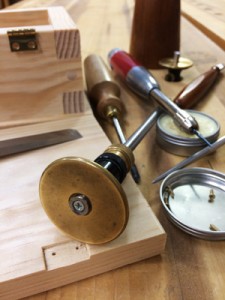New Tool Designs in Woodworking
*** previously published on Popular Woodworking's Blog ***
 Woodworking tool design progresses slowly. While it’s easy to state that today we have some of the best woodworking tools ever, the designs haven’t changed much. I mean, when a manufacturer takes advantage of modern metallurgy and manufacturing processes you can get some exceptionally high-quality tools – but that isn’t design change.
Woodworking tool design progresses slowly. While it’s easy to state that today we have some of the best woodworking tools ever, the designs haven’t changed much. I mean, when a manufacturer takes advantage of modern metallurgy and manufacturing processes you can get some exceptionally high-quality tools – but that isn’t design change.
Saws still have teeth shaped the same way, blades and backs of the same size and shape, and even handle designs (while a little larger on average) are the same shape as many in the historic record. The advances have been more in materials used and machining tolerances than in overall design.
That situation is even more obvious in the handplane realm. Shoot – even Lie-Nielsen states their planes are refined Bedrocks or other Stanleys.
The same can be said in the power-tool world, if you limit the scope to the realm of small shops or hobbyists. There have been exceptional leaps in the commercial woodworking world with CNC, laser cutters and water jets, but those are realistically out of the reach of most.
Because of another project, I’ve been thinking of design quite a bit this past week. This lack of radical innovation seems somewhat specific to the woodworking world. I know that automobiles have advanced and changed more from about 1985 to the turn of the 21st century than they did from the turn of the 20th century to 1985, mainly due to computerization. Medicine…don’t get me started. Even some of the most basic functions such as cooking have had major innovations in the past 30-40 years (microwaves, MREs, ceramics).
For the life of me, I was having a difficult time thinking of a modern woodworking tool design that has “stuck.” Seriously – I’d contemplated this for a few days and it was frustrating me. With all the advances we have had in my lifetime, basic woodworking tools haven’t changed much and I couldn’t figure out why.
And then, while installing some hinges, I found one: a design so perfect that its use is intuitive and practically disappears into your workflow with no thought. A tool that betters the performance of the design it replaces and brings along so much more.
I think brass wheel marking gauges, epitomized by the Tite-Mark, are radically different enough from traditional gauges that they might represent the biggest advance in woodworking tool design this century. Sure it’s a shaft and a head, but the function, shape and usage is so different than that of traditional marking gauges that it is a totally new design. The biggest advantages to the wheel marking gauge are, in my opinion, the adjustability, thin shaft and flush head.
It used to be that all a gauge did was mark a line, and the adjustments were kinda of crude. But now, how many of us use these flexible tools for measuring or cutting without a second thought. I know mine is used with every mortise to verify my tenon length, and it has become my de facto router plane when working on small things, such as hinge gains. The flush cutter head is easily sharpened and, due to the bevel, can be used just as effectively as a plane to level narrow dados, rabbets and grooves. I’m actually surprised nobody has developed different-shaped replacement carbide heads for these tools for that purpose.
And can we talk about accuracy and adjustability? They say that quality design is practically invisible – so simple and elegant as to be intuitive. I can put these tools into students’ hands and instantly they’re making fine adjustments and figuring out uses. With the old wooden rod and screw (or wedge) it was a bit hit-and-miss with accuracy. The tool was finicky, which adds frustration and requires instruction. Not so with this new design.
And to think: The design less than 20 years old yet now ubiquitous.
Can you think of a modern tool design that has infiltrated the woodworking community more that the brass wheel marking gauge?
